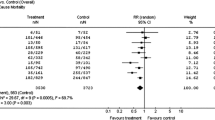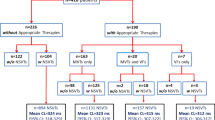Abstract
Background: In patients with implantable cardioverter-defibrillators (ICDs), 25 to 45% of tachyarrhythmia episodes were initiated by short-long-short RR intervals.
Methods: The prospective multi-center PREVENT study randomized patients implanted with ICDs capable of atrioventricular pacing, in order to compare—using a cross-over design with two 3-month treatment periods—the benefits of 'rate smoothing' (RS) as a 'pause-prevention algorithm' for the prevention of ventricular tachyarrhythmias.
Results: Follow-up included 219 patients with implanted ICDs, of whom 153 were eligible for analysis as per protocol. Fifty-seven of these patients (38%) had documented episodes of ventricular tachyarrhythmias during the six months follow-up. The total number of sustained ventricular tachyarrhythmia episodes was reduced from 358 with RS Off to 145 with RS On. RS was effective in reducing the number of short-long-short induced sustained ventricular episodes from 100 with RS Off to 40 with RS On. The Wilcoxon-Mann-Whitney point estimator equals 0.66 with a 95% confidence interval from 0.51 to 0.82 (relevant superiority; corresponding p = 0.039). There were no proarrhythmic effects due to rate smoothing within the scope of this study.
Conclusions: 'Rate smoothing' significantly reduced sustained ventricular tachyarrhythmias in ICD patients. There is a relevant superiority of the treatment during the early six months of follow-up.
Similar content being viewed by others
References
Daubert JC, Prystowsky EN, Ripart A. Prevention of Tachyarrhythmias with Cardiac Pacing. Armonk, NY: Futura Publishing Company, Inc. 1997.
Glikson M, Hayes DL, Nishimura RA. Newer clinical applications of pacing. J Cardiovasc Electrophysiol 1997;8:1190–1203.
El-Sherif N, Gough WB, Restivo M. Reentrant ventricular arrhythmias in the late myocardial infarction period: Mechanism by which a short-long-short cardiac sequence facilitates the induction of reentry. Circulation 1991;83:268–278.
Johnson EE, Rollins DL, Wolf PD, et al. Mechanism of ventricular fibrillation as mapped with 524 closely spaced simultaneously recorded epicardial electrodes. Circulation 1992;86:I–820.
Bayes de Luna A, Coumel P, Leclercq JF. Ambulatory sudden cardiac death: Mechanisms of production of fatal arrhythmia on the basis of data from 157 cases. Am Heart J 1989;117:151–159.
Gomes JA, Alexopoulos D, Winters SL, et al. The role of silent ischemia, the arrhythmic substrate and the shortlong sequences in the genesis of sudden cardiac death. JACC 1989;14:1618–1625.
Marchlinski F, Callans D, Gottlieb C, et al. Benefit and lessions learned from stored electrogram information in implantable defibrillators. J Cardiovasc Electrophysiol 1995;6:832–851.
Kay GN, Plumb VJ, Arciniegas JG, Henthorn RW, Waldo AL. Torsade de pointes: The long-short-long initiating sequence and other clinical features. Observations in 32 patients. JACC 1983;2:806–817.
Roelke M, Garan H, McGovern BA, Ruskin JN. Analysis of the initiation of spontaneous monomorphic ventricular tachycardia by stored electrograms. JACC 1994;23:117–122.
Schaumann A, Puhrer T, Herse B, von zur Muehlen F, Gonska BD, Kreutzer H. Insights into the onset of ventricular arrhythmias by stored electrograms of implantable cardioverter defibrillators. Eur Heart J 1996;17:504 (Abstract).
Wietholt D, Schueler K, Ulbricht LJ, Horlitz M, Schley P, Muzetto C, Guelker H. Higher incidence of 'short-long-short' induction of spontaneous ventricular tachyarrhythmias in patients with implantable cardioverter/defibrillators treated with Sotalol. JACC 1998;31:226c (Abstract).
Wietholt D, Schueler K, Ulbricht LJ, Horlitz M, Schley P, Guelker H. Same pattern of induction insustained and nonsustained spontaneous ventricular tachyarrhythmias in patients with implantable cardioverter/defibrillators. PACE 1998;21(II):826 (Abstract).
Funck-Brentano C, Coumel P, Lorente P, et al. Rate dependence of ventricular extrasystoles: Computer identification and quantitative analysis. Cardiovasc Res 1988;22:101–107.
Winkle R. The relationship between ventricular ectopic beat frequency and heart rate. Circulation 1982;66:439–446.
Fisher JD, Teichman SL, Frerick A, Kim SG, Waspe LE, Martinex MR. Antiarrhythmic effects of VVI pacing at physiologic rates: A crossover controlled evaluation. PACE 1987;10:822–830.
Jordaens E, Vandekerckhove Y, Van Wassenhove E, et al. Does rate responsive pacing suppress exercise-related ventricular arrhythmias? Stimucoeur 1986;14:93–98.
Fisher JD. Antitachycardia pacing in the acute care setting. In: Saksena S, Goldschlager N, eds. Electrical Therapy for Cardiac Arrhythmias. Philadelphia: Saunders WB 1990:411–423.
Johnson RA, Hutter AM, De Sanctis RW, et al. Chronic overdrive pacing in the control of refractory ventricular arrhythmias. Ann Intern Med 1978;80:380–383.
Eldar M, Griffin JC, Abbott JA, et al. Permanent cardiac pacing in patients with the long QT-syndrome. JACC 1987;10:600–607.
Silka MJ, Manwill JR, Kron J, McAnulty JH. Bradycardiamediated tachyarrhythmias in congenital heart disease and response to chronic pacing at physiologic rates. Am J Cardiol 1990;65:488–493.
Lascault G, Frank R. Effect of a new algorithm used for the prevention of premature ventricular complexes in dual chamber paced patients. Eur JCPE 1994;4:50–54.
Zacouto F, Juillard A, Gerbaux A. Prevention of ventricular tachyarrhythmias by automatic rate pacing. Rean Art Org 1982;8:3–11.
Gessman L, White M, Ghaly N, et al. US experience with the AddVent VDD® pacing system. PACE 1996;19:1764–1767.
Higano ST, Hayes DL, Eisinger G. Sensor-driven rate smoothing in a DDDR pacemaker. PACE 1989;12(6):922–929.
Maarse A. Ins and outs of rate smoothing. Technical memo. CPI/Guidant.
Bailin StJ, Mosier ML, Johnson B, Edel TB. Pause dependent ventricular arrhythmias treated with rate smoothing pacemaker. PACE 1994;17:863 (Abstract).
Viskin S, Fish R, Brosh D, et al. Prevention of pausedependent Torsade-de-pointes and malignant ventricular arrhythmias with a pause-preventing pacing algorithm. PACE 1998;21(II):826 (Abstract).
Breithardt G, Cam AJ, Campbell RFW, et al. Guidelines for the use of implantable cardioverter defibrillators: A task force of the working groups on cardiac arrhythmias and cardiac pacing of the European Society of Cardiology. Eur Heart J 1992;13:1304–1310.
Lachin, JM. Worst rank score analysis with informatively missing observations in clinical trials. Internal Report, The Biostatistics Center, Dept. of Statistics/Computer and Information Systems, George Washington University, 6110 Executive Boulevard, Suite 750, Rockville,Maryland 20852.
Koch GG. The use of non-parametric methods in the statistical analysis of the two-period change-over design. Biometrics 1972;28:577–584.
Zimmermann H, Rahlfs VW. Model building and testing for the change-over design. Biom J 1980;22:197–210.
Böcker D, Block M, Isbruch F, et al. Comparison of frequency of aggravation of ventricular tachyarrhythmias after implantation of automatic defibrillators using epicardial versus nonthoracotomy lead systems. Am J Cardiol 1993;71:1064–1068.
Zacouto F, Partat D, Gerbaux A, et al. Un nouveau pacemaker orthorhythmique avec ajustement de frequence automatique. Nouv Presse Med 1980;37:2693–2694.
Fontaine G, Frank R, Tonet JL, et al. Value and limitations of the DPG-1 pacemaker antiarrhythmic functions. In: Behrenbeck DW, Sowton E, Fontaine G, Winter UJ, eds. Cardiac Pacemakers. Darmstadt: Steinkopff Publisher, 1985:291–297.
Barnay C, Medvedowsky JL. Use of flywheel, automatic underdrive and dynamic overdrive in atrial pacers. In Behrenbeck DW, Sowton E, Fontaine G, Winter UJ, eds. Cardiac Pacemakers. Darmstadt: Steinkopff Publisher, 1985:238–247.
Winter UJ, Behrenbeck DW, Brill T. Hemodynamic overdrive pacing in implanted VVI pacemakers. In: Behrenbeck DW, Sowton E, Fontaine G, Winter UJ, eds. Cardiac Pacemakers. Darmstadt: Steinkopff Publisher, 1985:291–297.
Saoudi N, Limousin M, Nitzsche R, et al. The compensatory pause prevention algorithm: Structure and early evolution. Eur JCPE 1994;I:45–49.
Saoudi N, Limousin M, Henry Ch, et al. The compensatory pause prevention algorithm: Preliminary results at the ventricular level. In: Daubert JC, Prystowsky EN, Ripart A. Prevention of Tachyarrhythmias with Cardiac Pacing. Armonk, NY: Futura Publishing Company, 1997:169–178.
Wolpert C, Jung W, Herwig S, Schimpf R, Spehl S, Jeong KM, Yang A, Lüderitz B. Short-long-short induction of ventricular tachyarrhythmias is significantly reduced in implantable defibrillators (ICD) with AV-sequential pacing compared to single chamber ICD patients. PACE 2000;23:654 (Abstract).
Alt E, Coenen M, Baedeker W, Schmitt C. Ventricular tachycardia initiated solely by reduced pacing rate during routine pacemaker follow-up. Clin Cardiol 1996;19:668–671.
Leclercq JF, Attenuel P. Spontaneous onset of VT and VF episodes: Implications for prevention with permanent cardiac pacing. In: Daubert JC, Prystowsky EN, Ripart A. Prevention of Tachyarrhythmias with Cardiac Pacing. Armonk, NY: Futura Publishing Company, Inc. 1997:123–134.
Author information
Authors and Affiliations
Corresponding author
Rights and permissions
About this article
Cite this article
Wietholt, D., Kuehlkamp, V., Meisel, E. et al. Prevention of Sustained Ventricular Tachyarrhythmias in Patients with Implantable Cardioverter-Defibrillators—The PREVENT Study. J Interv Card Electrophysiol 9, 383–389 (2003). https://doi.org/10.1023/A:1027407829958
Issue Date:
DOI: https://doi.org/10.1023/A:1027407829958




